 Summer Test-Cutting Gathering (Houston, 2001) Summer Test-Cutting Gathering (Houston, 2001)
By Belinda Hertz
ARMA has always tried to stress the value of test-cutting
as an exercise for the swordsman and as erudition toward understanding
just what real blades could and could not do.
In June 2001, some of our members got together in Houston to finally hold another long-awaited
test-cutting day. This time inviting any and all ARMA members able
to attend to join in and while at it have a good old-fashion Texas
summer BBQ. Lunch was a delicious roast suckling pig, sausage, hot
dogs, country baked beans, Texas beer, and picnic fixings plus a unicorn
shaped piņata for the kiddies.
The opportunity to hit substantial test targets
with sharp blades was a first for many and for others another eagerly
welcomed occasion. The day was a chance to evaluate the cutting power
of a few different swords, to acquire an appreciation of the challenge
of actually cutting with a sharp, to “sharpen” our skills
with the exercise, to experiment, and just have some fun.
Approximately 18 different swords from 6 different
makers, 14 or so sharp and the remainder blunt, plus a few other weapons,
were used by the twelve or so participants. A wide variety of target
materials were used including: one-quarter-inch cardboard tubes (3
and 6 foot long), 1 inch and 1.5 inch bamboo stalks, foam “fun
noodles”, assorted plastic jugs, and 8-10 pound raw pork shoulders
as well as mail armor and leather. All swords performed very well
on a range of target materials especially the bare meat.
One particularly light and a-historical model of short sword however
had difficulty cutting into thick cardboard and was useless against
leather or armor. Though blade evaluation was not the objective of
the day, the best on hand were judged the Raven Armory blades. Some distinction was also noted among the many swords used in regard
to differences in blade cross-sections and width, as well a
small degree of difference between different edges or polishes was
detectable. |
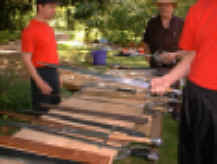
A fine Raven Armory's short sword, its keen edge and thick riser visible
in the light. |
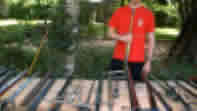
Some of the more than 18 tested blades and weapons
of various makes. |
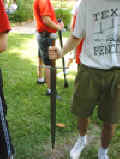
An excellent
Raven Armory's bastard sword. |
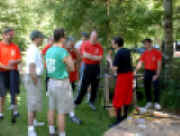
John C. with a fine Zamorino great sword from Toledo.
|
| ARMA Director
John Clements began the morning with a quick overview of a few safety
points for handling any sharp swords and for conducting of any test
cutting. Among the elements John stressed was the importance of treating
the weapon “like a loaded gun”, of clearing the test area,
of the direction of the cutting, and the need for a spotter.
A moment of sloppy technique,
a minor lapse in concentration or inappropriate body tension by a beginner
all can result in a nasty incision or laceration from a sharp blade.
This was followed by brief lesson on cutting in general and how using
historical techniques with correct mechanics and form are the only realistic
way by which to test either a sword’s or a swordsman’s ability. To underscore this, John talked briefly
about a few necessities in test-cutting such as: the 5 or 6 different
historical gripping methods to employ and their significance, the 8
cutting lines using the 5 or 6 fundamental cuts (out of a total of 14
historical true and false-edge strikes) --including the Meisterhau
(master cuts) along with the oft-ignored but important Krumphau.
Added to this were reminders on proper footwork stepping
and balance, as well as focus
and follow-through all to ensure fluidity and maximum force.
A final safety point was a warning on how
easy inexperienced students can injure themselves by cutting with too
much motion or with poor edge placement thereby causing a sharp blade
to bounce off a hard target on impact and hit back into them (a
warning to all untrained would-be “blade testers”). To
gauge either effective cutting or a good blade, the answer is to test
cut with as many different swords as possible on different targets –using
proper historical technique. |
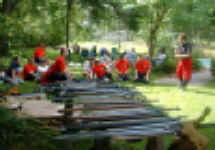
John C. goes over vital safety precautions for test-cutting with sharp
blades. |
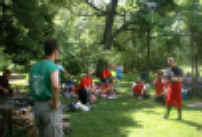
John C. talks about the different
grips, stances, and blows to focus
on during the day. |
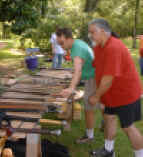
Fetch you choice of sword! |
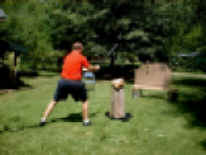
Murray Moore of New Mexico
tries his hand at hacking.
|
|
The importance of realistic “emotional
content” for proper energy in the throwing of blows was also
discussed. In an intriguing impromptu lesson
on this, John C. repeatedly made successive cuts through a 6-inch
thick cardboard tube with quick true and false edge cuts. Later, John cut a bamboo stalk down to the ground
with compound strikes along six of the eight different lines of striking showing proper movement
into and out of the target.
The various swords were tested in
a more or less historical manner, i.e., by being hefted and wielded
and put through their paces by students with a degree of familiarity
with what they were designed to do and who train physically to achieve
it. Subjectively testing the blades as “weapons” in this way is more natural and holistic (as opposed
to any quantitive analytical evaluation of construction). The same
testing is applied to each student’s own individual performance
of cuts. It's more difficult
than it sounds to make a clean cut with the edge of a steel sword than most enthusiasts
realize. At the same time, the object is to just hit hard with
the edge, not make some “aesthetically” perfect” slice.
Even for experienced practitioners who have not had
lengthy occasion to engage in the exercise, it can be a humbling experience.
Even though the target is for the part standing still and not
hitting back, it can be easy to skim off or miss it clean. Seeing
a skilful swordsman adeptly swing a sharp sword with ferocity and
finesse can really make you appreciate what a fine blade can do in
the right hands. It once again underscores how much
stunt-fighting and fantasy role-playing games so commonly misrepresent
bladed combat. In any evaluation of a sword (replica or antique),
while cross-sectional shape along with moment-of-inertia have
a great deal of bearing on the blade’s ideal center-of-percussion
(and therefore cutting power), ultimately, how the sword feels and handles to the wielder are the crucial criteria. These attributes
are best presented by experienced practitioners using correct form
and body mechanics.
|
|
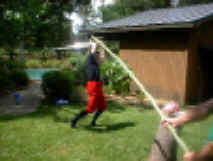
Caught in the act...
|
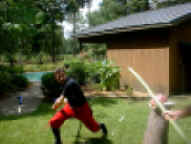
Follow through and preparation for follow-up...
|
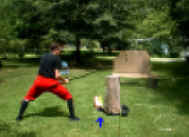
A split second after a blow was struck, the recovery of pulling
the weapon back literally lifted 8 pounds of meat and
the
phone book it rested on of the log pedestal.
|
|
Some
surprising elements revealed from hacking at meat were the bone chips,
bone dust, and flying particles of flesh that occurred with long-swords and great-swords.
Some cuts on fresh bone produced noticeably small shards and chips
of bone when they cut through the target. Others showed a “bone dust” on the blade as well
as the wound. Several
times thin “filets” of meat flew out, torn from the cut,
as the blade withdrew. As well, one powerful blow even “bounced” up and out and then back down again to make a second smaller cut,
all in the blink of an eye.
On one occasion, a blow failed to cut into the bone but managed
to clearly break it and crush a portion. On another against leather covering
meat, the leather was not penetrated by the blow but the surrounding
flesh was ripped clean away from the bone leaving the fresh white
enamel beneath.
One of the more unique experiments
was on hanging meat. A large pork shoulder was hung from a rope at
roughly head level to offer a more realistic level of resistance and
after-motion effect. The
target’s slight movement also added to the result.
The cuts made in this manner against hanging meat and
bone actually did greater damage than did those on targets that were
placed on the log stand. It was good to have the chance to compare sword damage with that from
other weapons, like the hammer and axe or spear. Some
of the guys also took out time to practice spear throwing at hay bales
and even mail armor. Several learned it wasn’t easy to hit a
stationary target a mere 30 feet away. Also practiced was a little
hatchet throwing.
|
|
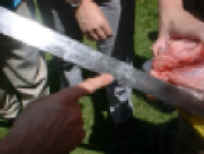
After striking hard on fresh bone a blade shows a splattering of fine "bone powder". Chips of bone shard and powder also coated
the wounded meat.
|
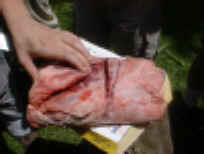
Three deep cuts on a block of meat visible from a variety of blades. The far right being done by a blunt sword.
|
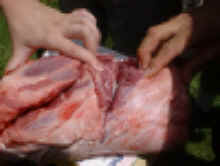
Checking the width and depth of a clean hewing blow.
|
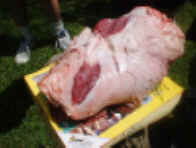
Muscle just does not stand up well to hits by thin, wide, hard metal.
|
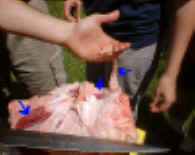
A Raven short sword and a hand full of flesh and fat literally (far right arrow) ripped out of the wound as the blade forcefully withdrew from the cut. The blade itself shows residue from where it was struck. Other arrows depict cuts made by the very tip. Several strikes were specifically made with the first 1-3 inches of blade, and in some instances this actually proved better results than striking with the center of percussion farther down the blade at the "sweet spot". |
|
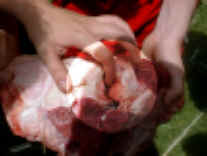
A deep cleaving blow shearing though the heaviest bone and cracking the portion.
|
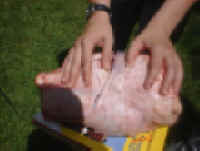
A wide and deep cut.
The gruesome reality of what steel does to flesh...
|
|
A range of important principles and concepts
from the historical texts can come to light under proper test-cutting,
such as the Blitzen (flashes) and the “bouncing jolt”
of flats alluded to in the teachings of the 14th century fencing master Johannes Liechtenauer. Also worth mentioning, was that
at no time on any cuts against meat or armor did any blades “vibrate”
or experience any awkward feedback transferred along the blade or
to the handle. Blades
cutting into targets do not “vibrate.”
However, they will flex on impact, and may wobble when struck incorrectly
or struck hard themselves. Fortunately, during the day very few blows
were thrown incorrectly or off line so as to cause the edge to skip
and the blade to then flex or wrap so it bounced back (this tends
to happen on much larger or far more solid targets than human
bodies).
|
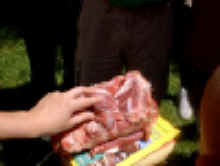
A horrendous cut, some 6 inches deep clearly shearing through meat and
into bone. |
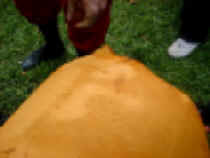
A thick piece of buff leather (placed over meat) shows only a small
surface mark from a sword. |
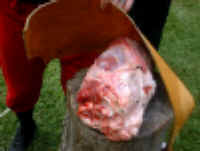
Underneath is a different story as the meat lies pulverized and twisted.
|
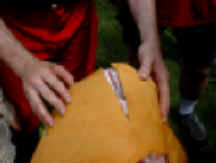
A sharp Del Tin long-sword reveals the weakness of simple leather armor
alone...The leather was cut over about 4 inches but the cut only went
all the way through for about 1/2 inch. The meat was cut over
a length of about 3
inches to a depth of 1 to 1 1/2 inches. |
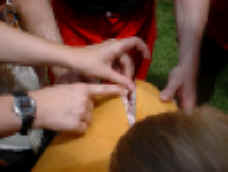
The depth of the cut becomes apparently...3 inches.
The cut in question was made two handed and somewhat
overreached such that
the blade hit the target closer to the guard than it should have.
|
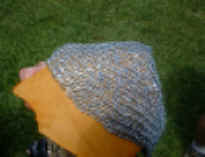
Some riveted mail and leather prepared for testing. |
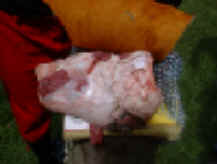
Mail over leather makes a good defense. But below the damage (center)
is clear. The surface fat is severely brutalized and severed open.
Mail armor easily turns the edge of a sword,
but it does nothing to prevent the blunt trauma shock of the blow’s
from transferring to the soft tissue or bone beneath. |
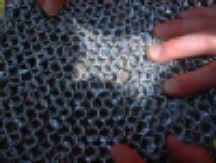
Some riveted mail proved excellent as resisting cuts from lighter blades,
but against long-swords shows several popped, snapped, and twisted as
well as missing links. |
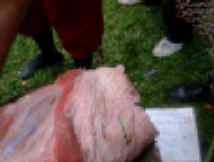
Without a gambeson, butted mail over flesh alone proved terribly ineffective.
Note traumatized and shredded effect of the tissues. |
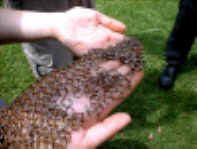
Butted-mail revealing it's all but destroyed even by blunt blades. |
|
|
A lot of thick cardboard sheets were present,
but were used more for just showing rapier tip cuts than anything
else. Cardboard sheets do not simulate much
of anything, can be sheared easily even by blunt blades, and cardboard actually tends
to dull sharp edges quickly. About three-dozen plastic water jugs of various
kinds were on hand for cutting on, but it was quickly demonstrated
that for realistic cutting practice they (like pastic soda bottles) are insubstantial and easily
cut clean through by even completely blunt swords.
However, they were somewhat useful for showing a student's edge placement
and follow through and the need to cut quickly. Cuts were made at
jugs tossed through the air, allowing the student to split them in
two while in mid air. Other cuts at jugs were made that cleanly cut
them diagonally or even horizontally without spilling the remaining
water or moving the jugs off the log they sat on. Secondary follow-on cuts sheared off
further pieces of the thin plastic jug again without disturbing its
position of content. Thus, plastic jugs were mostly passed on.
Another observation: the rapiers were used against thick carboard
and 1/2" to 1" thick bamboo and sheared them quite easily (saying more about
how easy it is to cut small pieces of bamboo than about the actual cutting
power of slender rapier blades). This makes us wonder if perhaps some claiming
to have "test cut" with rapiers to "confirm" that
they can "cut through hands and arms" are in fact merely cutting
similar target materials without recognizing the difference in cutting actual
fresh raw meat and bone underneath cloth? |
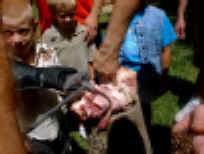
A three-inch hole through
mail punched by a
war hammer's spike. |
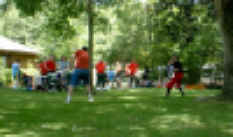
Cutting at a
moving stalk of bamboo. |
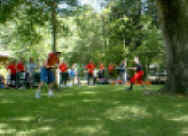
Harder than it looks. |
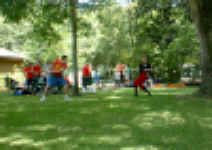
The tricky part...when it gets down to the last 5 feet --just toss
it at them!
|
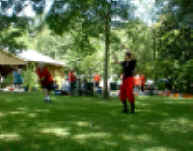
Striking at the appropriate angle, location, and distance while
maintaining proper motion, energy focus, edge-placement,
and follow through (...and they thought it was just about
hitting hard?) |
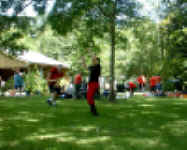
Snip!...and cut again...Earny Perez takes a turn. |
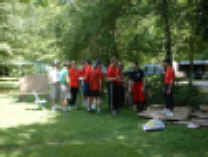
Preparing to set up targets.
|
|
Care must always be taken in wielding any
sharp blade, especially and particularly when swinging it close around
oneself. Inexperienced practitioners can easily loose sense of just
where and how far an edge can go (yet one more reason why test-cutting
needs to be supervised by experienced swordsmen). One practitioner (a police officer
well used to gun safety) did just this and caused the back edge of
a long sword to barely touch his left knee after cutting diagonally
down right-to-left. A minute later after a few more strikes a thin
trickle of blood in the summer heat revealed he had made a two-inch
slit in the skin where he had caused the edge to “kiss”
him. The result for lack of calm awareness and proper mental centering
was 14 stitches to his knee from a simple tapping “bump.”
Greater emphasis on first developing proper form as well as
wearing knee and shin pads would have prevented his inconvenience
and discomfort. Importance
of good hilts and handles was also reiterated as two wooden grips
seriously cracked, one Del Tin great-sword bent about 20 degrees at
the tang from a single cut, while another Del Tin long-sword bent
15 degrees at the tang weld of the steel rod. At one point, too low of a strike
with the finely honed Raven blade caused it to go through the target
and bite the iron dry rod sticking out of the ground as a make-shift
cutting stand. Yet, despite the strong cut, the result of hitting
the iron rod was neither a chipped nor folded edge but an eighth-inch “wrinkle.”
One brief day does not do justice
to the exercise of test cutting, but it was good for students who
had never cut before to get in some practice and new insights always
occur under such efforts. The main lesson for students to take home
after the day’s cutting was proper energy, focus, and edge-placement.
There is nothing like some serious test-cutting to make one appreciate
a good sword and a good swordsman.
|
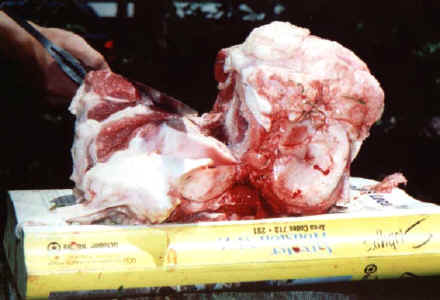
The shearing power of a good sword
--the bone here was
cleaved lengthwise by this Raven Armouries sword. |
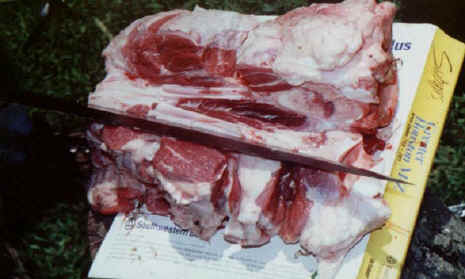
A closer look. The raw fresh beef shoulder was sheared
almost clean in two --and from an unsharpened blade! |
|
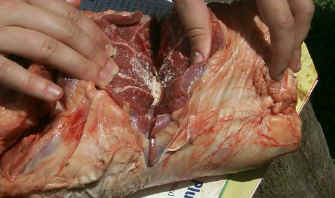
A deep cleaving cut showing splintered
bone and "powdered" shards.
|
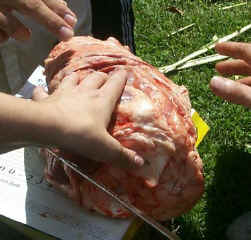
Some of the first test cuts,
deep but slender wounds.
|

Cutting at sitting target beef. |

The damage. Splitting even the bone. |

Leather resists some blows, particularly
from narrower blades. |

More butted mail easily trashed by
even dull blades.
|

Experimenting with cuts
on hanging beef target. |

Even novices need to have some basis
for understandng what a sharp weapon really does when it impacts flesh. |

Ochs vs. the hanging beef. |
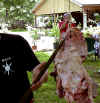
|

No carboard boxes and twig branches here. Just flesh and
bone. |

A simple tip slash of a short-sword delivered from the
half arm makes a deep cut to the bone. |
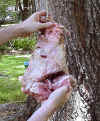
A horrendous wound from a
simple slash of a long-sword. |

Another cut.
|

Evaluating the result. |

Inspecting effects. |

Evaluating a cut. |

Conjecturing on cutting technique. |

A terrible blow nearly cleaving the beef in two. |

A Del Tin blade with virtually no miles on it bend at the tang weld of the
bar rod during one cut. |

Padded-contact weapon free-play. |

Group free-play fighting. |

Watch out for the electrified cow fences...they're live! |

Down he goes... |

Bring it on... |

The hazards of inattention to sharp metal objects, a slit knee. |

Look close here and you'll note a back splattering of raw meat as the blade
impacts! |

The day's selected weapons. |

Reactive test-cutting exercise. |

For the kiddies: A pinata is decapitated
in a splatter of candy. |

The gang poses. |
|
|
|
|
Back
to Spotlight
|
|
|
|

